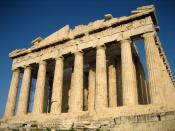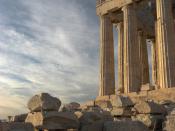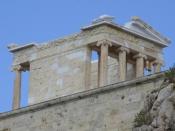A temple was dedicated to a God and used as a place of worship, although access was restricted to priests and it housed the statue of the god/goddess. An altar, where sacrifices would be made to deities was placed outside of a temple so that many people could see and that the smoke would drift up to the home of the Gods, Mount Olympus. Therefore the focus of religious worship was in the surroundings of a temple, hence sanctuaries were built. Sanctuaries were the site of religious festival and processions as well as athletic events and theatrical performances. Therefore housed a number of non religious buildings as well and the placement of the buildings was essential. One of the largest sanctuaries in Ancient Greece was the Acropolis of Athens. The Greeks built their towns in plains near or around a rocky hill that could easily be fortified and defended.
In many cases the hill became the site of temples and public buildings and therefore served as the town's religious centre and the focal point of its public life and as a place of refuge. Other important factors included, being near water or in the case of Delphi, being near the Oracle. The best-known example is the Acropolis of Athens. Built on a limestone hill, the Acropolis dominates the city of Athens. It contained the Parthenon, a temple dedicated to the goddess Athena; the Propylaea, a monumental marble gateway and the main entrance to the Acropolis; the Erechtheum, another temple; and the Temple of Athena Nike. During the late Bronze Age (1450 to 1200 BC), a heavily fortified palace citadel was built on the hill, and a massive stone wall was built around it. During the Mycenaean times the Acropolis probably remained a fortification tool while also becoming...


